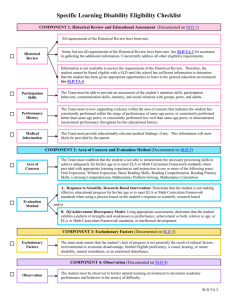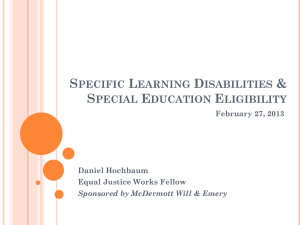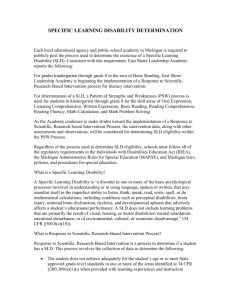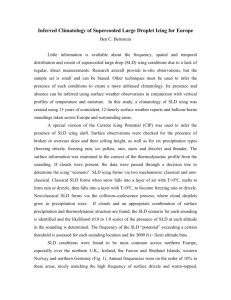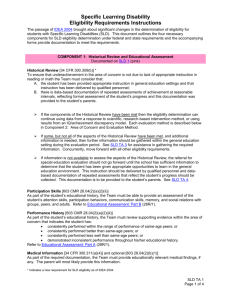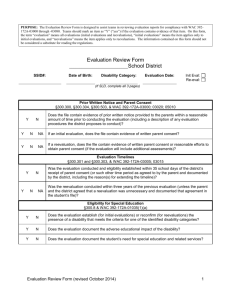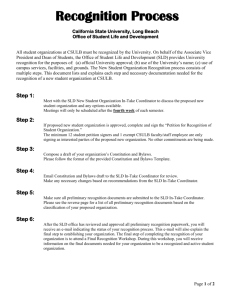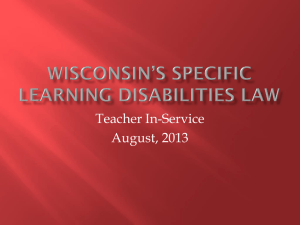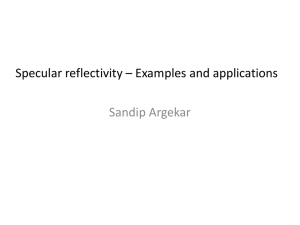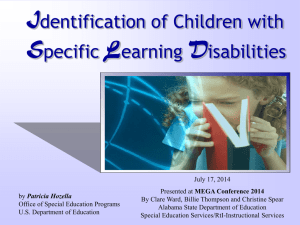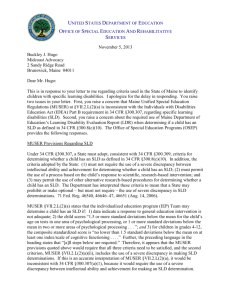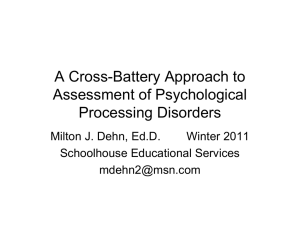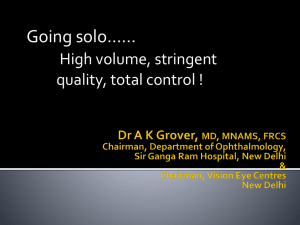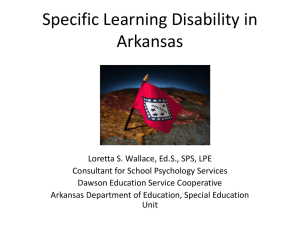SLD Academy 1.0 - HISD Special Education Updates
advertisement
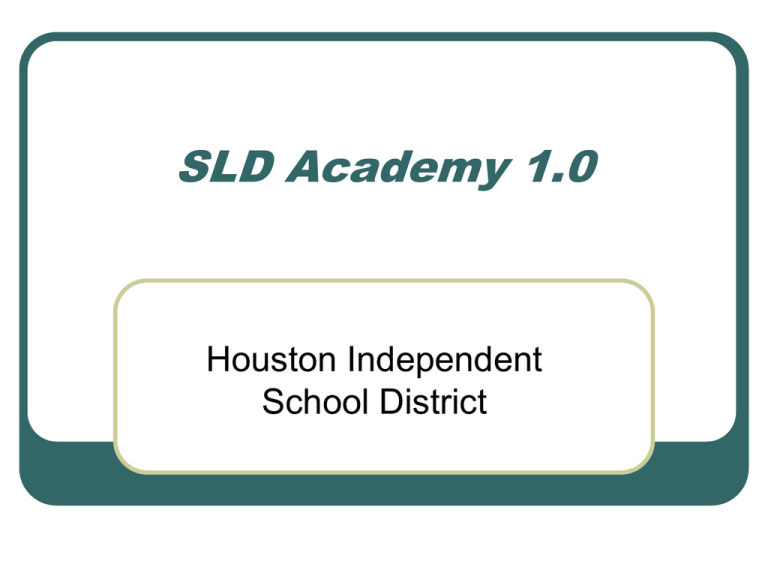
SLD Academy 1.0 Houston Independent School District Academy Goals Understand the flaws of the traditional discrepancy model Avoid the use of the discrepancy model in SLD identification Explore assumptions of CHC theory and principles of XBA assessment Identify narrow abilities linked to academic learning Understand normative versus relative weaknesses to identify SLD HISD Core Initiatives Effective Teacher in Every Classroom Effective Principal in Every School Rigorous Instructional Standards and Supports Data Driven Accountability Culture of Trust through Action HISD’s Special Education Mission To support students with disabilities in gaining college and career readiness through active engagement in the grade level curriculum. Why is quality SLD evaluation needed to enable students to access grade level curriculum? Understand the Flaws of the Traditional Discrepancy Model “Given what we now know about LD, it is irresponsible to continue current policies that dictate inadequate early identification practices.” -Rethinking Special Education for a New Century What is wrong with using the overall IQ in SLD identification? Matthew’s Effect Limits of potential? Individual Differences CHC Theory 1. Represents individual differences 2. Fades emphasis on an overall IQ when applied to eligibility determination 3. Aligns to academic learning 4. Establishes a nomenclature for psychological-educational assessment General Conceptual Ability (GCA) Fluid Reasoning (Gf)) ComprehensionKnowledge (Gc) Short-term Memory (Gsm) Long-term Retrieval (Glr) Auditory Processing (Ga) Processing Speed (Gs) Visual-spatial (Gv) HISD Assumptions 1. 2. 3. 4. 5. RtI and identification via the ability-achievement discrepancy model alone are currently not sufficient for SLD identification. Comprehensive evaluation should occur once a student has failed to respond to general education interventions. Assessment of cognitive and neuropsychological process are used not only for identification, but to allow ARD committees to better understand individual differences. Assessment of cognitive and neuropsychological processes are used to identify potential barriers in accessing the gradelevel curriculum and provide recommendations to mitigate the effects of a SLD. The identification of SLD must involve the investigation of a pattern of psychological processing strengths and deficits, and the relation the deficits have and may not have to formal and classroom achievement. Relationship to Academics Gc Verbal ability Gf Fluid Reasoning Glr Long-Term Retrieval Gsm Short-Term Memory Strong and consistent across all academics and ages Significant across all academics, especially with higher level skills Significant and moderate across all academics, especially in primary grades Significant across all academics, Working memory especially relevant to higher level skills © 2008 Statewide Leadership: Evaluation Relationship to Academics Gv Visual Processing Ga Auditory Processing Gs Processing Speed No significant relationship as measured in IQ tests currently except with higher level math. Significant relationship across all academics during early grades Significant to all academics especially in early to mid-grades © 2008 Statewide Leadership: Evaluation Crystallized Knowledge (Gc) Process Declarative Lexical Knowledge General Knowledge Listening Ability Language Development Fluid Reasoning General Sequential Reasoning Ability to problem solve when rules are given Quantitative Reasoning Classroom Related Based on formal instruction Induction Ability to discover rules Short-term Memory Working Memory Memory Span Visual Organization of information Recall within 7 seconds Long Term Retrieval Associative Memory Naming Facility One thing reminds us of another Rapidly produces names of concepts Using CHC Theory in SLD identification Use at minimum two qualitatively different narrow abilities when assessing a broad ability Assess narrow abilities that are associated to the academic deficits and narrow abilities that are not associated to the academic deficits Attempt to measure all seven broad abilities Practice Select either a Secondary or Elementary example from the Assessment Planning Exercise and plan a SLD evaluation. Do cognitive deficits occur that are aligned with classroom functional limitations? • • • • • A priori A posteriori Confirmatory bias Null Hypothesis Ipsative Does a functional limitation exist (normative weakness) in the classroom? Does formal academic achievement assessment confirm the presence of a functional limitation? A Priori You know it is true simply by sitting on the “couch.” Knowledge gained from deduction, independent from experimental evidence. Based on theory Example: A bachelors are unmarried Reading Comprehension is related to Gc A Posteriori Knowledge gained from experimental evidence Truth is not known without investigation Example: Some bachelors are unhappy Example: Gc deficits explain the reading difficulties for this student Confirmatory Bias Avoid beginning assessment with a preconceived notion Avoid becoming predisposed to seeing patterns to support prevailing assumption Null Hypothesis Represents an assumption that all children exhibit average abilities, but not required in report writing. Ipsative In relation to one’s self Example: The IQ-Achievement discrepancy Definition (IDEA, 2004) See Section 300.8(c ) (10) A disorder in 1 or more basic psychological processes involved in understanding or in using language, spoken or written, which disorder may manifest itself in the imperfect ability to listen, think, speak, read, write, spell, or do mathematical calculations. Includes perceptual disabilities, brain injury, minimal brain dysfunction, dyslexia, and developmental aphasia. Regulation Child exhibits a pattern of strengths and weaknesses in performance, achievement, or both relative to age, grade level standards, or intellectual development or intellectual development, that is determined by the group to be relative to the identification of SLD Name: test Age: 12 DOB: 12/10/1995 Date of Test: 12/10/2007 WJ III® Data Normative Weakness Normative Strength Average Range COMPREHENSION/KNOWLEDGE (Gc) Verbal Comprehension General Information LONG-TERM RETRIEVAL (Glr) Visual-Auditory Learning Retrieval Fluency VISUAL-SPATIAL THINKING (Gv) Spatial Relations Picture Recognition AUDITORY PROCESSING (Ga) Sound Blending Auditory Attention FLUID REASONING (Gf) Concept Formation Analysis-Synthesis PROCESSING SPEED (Gs) Visual Matching Decision Speed SHORT-TERM MEMORY (Gsm) Numbers Reversed Memory for Words UNITARY 40 45 50 55 60 65 70 75 80 85 90 95 100 105 110 115 120 125 130 135 140 145 150 155 160 Standard Score Note: Bars represent the obtained standard score +/- 1 SEM (5 points for indexes and clusters and 7 points for subtests), thus yielding an approximate 68%confidence interval for the values © 2008 Statewide Leadership: Evaluation Non - UNITARY UNITARY Interpreting a cognitive profile Gc = Non-Unitary: KO 97, VL 75 • • • Rule out examiner error Rule out examinee error Assume the weaker ability is anomalous (i.e. not true) to avoid confirmatory bias & administer a similar subtest Gc = Weakness: KO 97, VL 75, VL 73, Gc = Non-interpretable: KO 97, KO 93, VL 75, VL 73 • Interpret the clusters independent of one another Practice Review the sample evaluation and apply the Report Review Form. Performance Assessment
